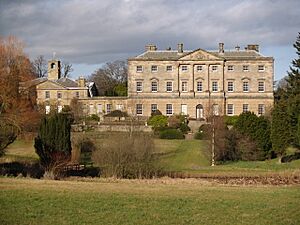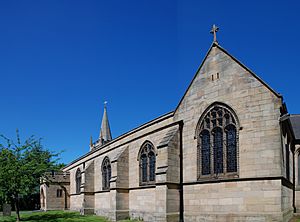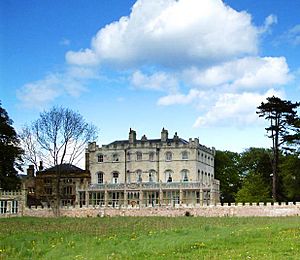William Newton (architect, 1730–1798) facts for kids
William Newton (born 1730, died 1798) was a talented English architect. He mostly worked in the areas of Newcastle upon Tyne and Northumberland. His buildings often looked grand and classic, like ancient Greek or Roman temples. This style was very popular in the late 1700s.
William Newton was influenced by other famous architects like Robert Adam. Most of his designs were for large, beautiful homes in the countryside. But he also created some important public buildings in Newcastle. These included The Assembly Rooms, St Anne's Church, and the Guildhall. He also designed elegant private houses in Charlotte Square.
About William Newton
William Newton was the son of Robert Newton, who was a builder. This likely helped him learn about construction from a young age. He married Dorothy Bell and lived for 28 years at 1, Charlotte Square in Newcastle.
His big chance came in 1774. He was chosen to be the architect for The Assembly Rooms in Newcastle. This project made him very popular with the wealthy families in Northumberland. People even called him 'the first truly Northumbrian architect'. This means he was seen as a very important designer from that region.
Famous Buildings by William Newton
William Newton designed many important buildings during his career. Here are some of his most well-known projects:
- St Ann's Church, Newcastle (1764): This church is a good example of his work on public buildings.
- Charlotte Square, Newcastle (1770): He designed these elegant private homes.
- Kielder Castle (1772): He worked on this historic castle.
- Assembly Rooms, Newcastle (1774-1776): This was a very important project for him. It helped him become famous.
- The Castle, Castle Eden (around 1775): Another castle he helped design or improve.
- Backworth Hall (1780): A large country house he worked on.
- Charlton Hall (1782): One of the many stately homes he designed.
- Howick Hall (1782): A beautiful country estate in Northumberland.
- St Nicholas Cathedral, Newcastle (1783-1787): He helped with the inside restoration of this important cathedral. He worked with another architect, David Stephenson, on this project.
- St Bartholomew's Church, Longbenton (1790): Another church he designed.
- Guildhall, Newcastle upon Tyne (1794): He helped redesign the front of this important city building, also with David Stephenson.
Other Possible Works
Sometimes, it's hard to know for sure who designed every old building. Experts look at the style of a building to guess who might have designed it. Some historians believe William Newton might have also designed these buildings:
- The Lodge in Capheaton village
- The South wing of Craster Tower (1769)
- Close House (1779)
- Newton Hall
- Togston Hall
- Broome Park, Edlingham (this building was taken down in 1953)




